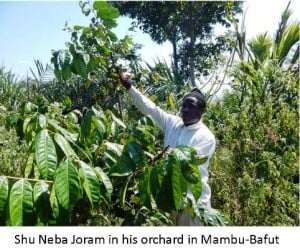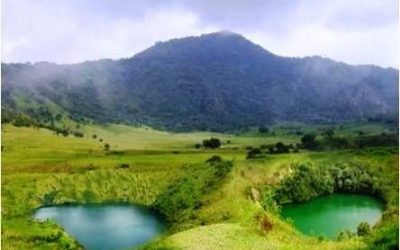
By Blaise Jumbam, Payong Prudence & Njumbe Peter Salle
Poverty often leads communities to engage in unsustainable, sometimes even outright reckless exploitation of natural resources. This alone makes any efforts to conserve and protect the environment almost worthless.
One of the factors that determine the economic wellbeing of farmers is soil fertility. Therefore, improving the fertility of soils is paramount to raising the standards of living of rural farmers through high crop yields and sustainable energy sources.
Environmental conservation is very physically demanding but ERuDeF’s Agroforestry Program is a promising effort to improve the wellbeing of people living in rural areas and near protected areas, with the aim of reducing pressure on endangered natural resources.

In the process of implementing an ambitious agroforestry program, ERuDeF has seen growing interest in the practice in four regions of Cameroon, meeting several goals: revamping soil fertility using nitrogen-fixing tree species (Acacia, Leucaena and Calliandra), increasing crop yields, optimizing farm acreage, water catchment conservation, medicinal plants production (Prunus, Neem and Moringa), timber and non-timber and forest products (NTFP) development.
Agro-forestry practice caught full momentum last year 2015, and is becoming even more popular because of the benefits it offers to the parties involved in it.
Farmers now have more than four options for planting agro-forestry species. They can fertilize their crops with the leaves of the trees or they can feed their animals on the same leaves. The farmers can conserve water catchments and also keep bees that use nectar from the flowers of the agroforestry trees to make premium honey. Besides, they can use mature trees for fuel wood and as wind breaks etc.
Significantly higher revenues dissuade farmers to overuse the environment (forests, water sources) consequently conserving the environment.
ERuDeF’s Agroforestry Progam has more than 100 farmers who, have contributed to these results with the Forest Garden System that incorporates land ownership, farm optimization, alley cropping and terracing/contouring, all under the guidance of experienced agroforestry technicians. Out of these 100 farmers, over 40 farmers implemented these agroforestry techniques and are very happy with the results.
“We were able to plant over 2,000,000 trees of Acacia, Leucaena, Calliandra, Prunus and Moringa in the different Forest Gardens; these trees would start yielding fruit from the third year of inception. However, some farmers who have been practicing this for the past three years have been enjoying remarkable benefits through increased crop production due to improved soil fertility.
In Bamboutos Division, agro-forestry famers reported that they have experienced a rise in the yields of crops such as maize, beans, cocoyam and cassava, thanks to the nitrogen-fixing power of agrofroestry trees planted in alleys in their farms.
“The life of my household is changing for the better due to the sale of the honey from my beehives, thanks to the nectar from Acacia and Leucaena that I have planted,” says Mbuh Thomas who has been practising bee farming
Another agroforestry farmer, Jeukeng Joseph, has been using agroforestry trees for fuel wood and pegs for his beans. He now has surplus fuel wood and is making some money from the sale of this wood.
“The livelihood of my family has improved a lot,” says Jeukeng.
Agroforestry has become an important alternative in land management systems to improve rural livelihoods due to its capability to generate employment and income. In Cameroon, ERuDeF is driving the new enthusiasm for agroforestry. There has been an increase in the practice in rural areas in recent years. Farmers are very much aware of what they are beginning to benefit from inter-planting their crops with agroforestry species. If farmers can understand the agroforestry product value chain; activities, added value, employment, profit distributions, they will see more yields and put more money in their pockets. ERuDeF’s agroforestry system project aims to do just that; improve the roles of agroforestry through a systematic value chain analysis of products, both timber and non-timber to promote a more strategic contribution of agroforestry system.
Already, agroforestry practice is presenting the activity of the local community, the first level actor in the value chain, in processing products such as fruits, coffee, Moringa and honey, due to knowledge and skills acquired.
Field analysis suggests the need to extend the existing agroforestry system to other areas. This is to grow more profitable agroforestry products and increase the capacity of local communities not only in agroforestry management, but also in processing and marketing of agroforestry products.
For example, a study of existing agroforestry practices in Oweh in Muyuka Sub-division in the Southwest Region shows how value chain development supports effective interventions to improve local community livelihood particularly in generating employment opportunities and income. The preliminary data indicates that the existing agroforestry management system has made considerable contribution to employment and income generation.
ERuDeF therefore is pushing for the development and use of environmentally friendly forest, tree and agroforestry (FTA) value chain also known as market supply or commodity chain or production to consumption system. These concerns the activities involved in bringing a timber or non-timber product from the tree or forest, through processing.
To deliver this service to final consumers the following activities will be disposed: harvesting, cleaning, transport, design, processing, production, transformation, packaging, marketing, distribution and support services. These activities will add value to a product as it moves along the chain engaging harvesters, processors, traders, retailers and service providers. All these actors will multiply values along the chain that would benefit the communities economically, socially, culturally and environmentally.



